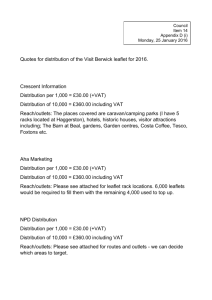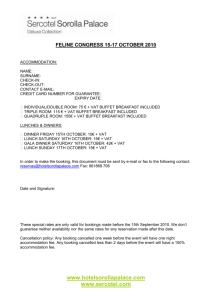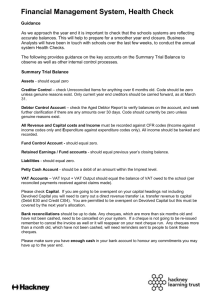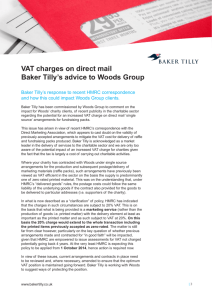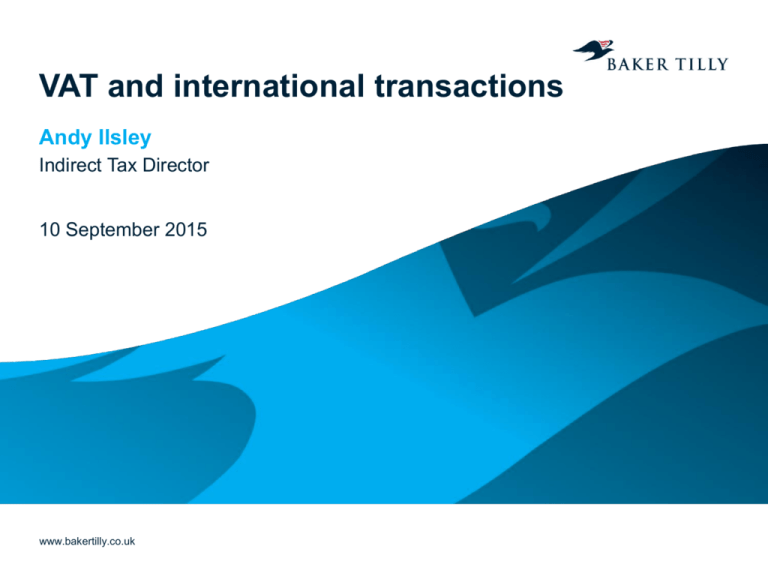
VAT and international transactions
Andy Ilsley
Indirect Tax Director
10 September 2015
www.bakertilly.co.uk
Agenda
• Introduction and context
• EU VAT principles
• Export evidence
• “Place of supply” of services
• Customs duty issues
• E Services and MOSS
2
Introduction and context
www.bakertilly.co.uk
Introduction and context
• International tax is on the agenda – BEPS project, increased
routine sharing of information cross border
• Risk Management is a key part of international expansion
• Need to understand principles and obligations
• Financial penalties and increased costs of non-compliance reduce
profitability
• Most countries have a VAT or GST (even US are thinking about it)
4
EU VAT principles
www.bakertilly.co.uk
Place of supply of goods
Place of supply of goods
Goods not despatched or transported (remain in that territory)
• Place where goods are when supply takes place
Goods despatched or transported (to another territory)
• Place where despatch or transport begins
Exceptions
• Where place of departure is outside member states
• Place of supply is member state of importation if supplier acts as
importer
Note – not necessarily related to PE status
6
Place of supply of goods (cont’d)
Installed or assembled goods
Where the goods are installed or assembled
• Place where goods are when supply takes place
However:• Rules vary depending on the member state
• It may be possible to avoid registering
• Customer accounts for the VAT on your behalf
• Implications even where sub-contractors are used to fulfil contracts
7
Intra-community supplies of goods
Supplier – conditions for zero rating
• Supply involves removal of goods from UK to a VAT registered person
in another member state
• Supplier quotes the customer’s VAT registration number on the sales
invoice plus two digit country code
• Supplier obtains valid commercial evidence of removal of goods from
the UK within three months of supply
• Otherwise the goods are standard rated for VAT purposes
* APPLICABLE TO EU MEMBER STATES
8
Intra-community supplies of goods
Evidence of removal from the UK
No official HMRC documentation
Commercial documentation includes:• Shipping documents
• Customer’s order/evidence of payment
Invalid VAT numbers
Supplier should check customer’s VAT number
• Scope for fraud
• Increased scrutiny by HMRC
• Potential joint and several liability for the VAT
Supplier not held responsible for output VAT if:• He has taken all responsible steps to check validity
• All other conditions for zero rating are met
9
Triangulation simplification
GRCo
UKCo
goods
FrCo
Tax points
Special tax points - Intra community supplies of goods and
acquisitions
Where any supply of goods involves both:• The removal of the goods from or to the UK
• Their acquisition in another EU country or in the UK
Time of supply is earlier of:-
• The 15th day of the month following that in which the goods were
dispatched or received
• The date of the issue of a VAT invoice
11
Call off stock and consignment stock
Call off stock
• Transferred goods held effectively in the control of the customer
• Simplification if stock destined for one named customer
Consignment stock
• Transferred goods held in the control and ownership of the supplier
• Customer or customers unknown at the time of consignment
• VAT registration implications
12
Movement of own goods
13
Exports
www.bakertilly.co.uk
Exports
Condition for zero rating
• Goods must be removed from the UK to a destination outside of the EU
• Supplier must obtain satisfactory evidence of export
• Goods must not be delivered to or collected by UK person or UK
customer at a UK address, even if claimed for subsequent export
• Goods must not be used in UK before export
• Only the final supply in a series of transactions can be zero rated, ie the
supply to the overseas person
15
Exports (cont’d)
Main types of exports
Direct exports
• Arrangements under supplier’s control
• 3 months for the goods to physically leave the UK
Indirect exports
• Arrangements made by someone other than the supplier, eg the
customer collects from your premises
• 3 months for the goods to physically leave the UK
• Supplier still retains responsibility and liability for the export
• Supplier should consider taking a deposit equal to the VAT
UNDERSTAND THE INCOTERMS!!
16
Exports (cont’d)
Evidence of export
• Supplier needs to take all reasonable care and to ensure that evidence
of export is obtained and retained
Evidence consists of:• Official documents
• C88 stamped by HMRC
• Commercial evidence
• Sea waybills, air waybills etc
• Certificate of shipment
17
Place of supply of services
www.bakertilly.co.uk
Place of supply of services
Place of supply of services rules
General rule
• Place of supply is where the business customer (B2B supplies) is
established provided the customer is acting as a taxable person
• Business customer accounts for VAT via reverse charge mechanism
• Place of supply of services supplied to non-business customers (B2C
supplies) remains where the supplier is established
19
Place of supply of services (cont’d)
Key issues
• Evidence that customer is in business (EU VAT number)
• Are you supplying to a taxable person acting as such?
• Public sector/charities – always apply general B2B rule even if
services will be used for non-business purposes
• Businesses below VAT registration limits – alternative evidence of
business activities (eg letter from Chamber of Commerce or tax
authorities)
• Supplies for private use – always use B2C rules
• If in doubt, apply B2C rules – can always adjust later
• Impact upon global contracts is not clear
20
Place of supply of services (cont’d)
Place of belonging
• No statutory definition to determine which establishment makes or
receives a supply but the aim is to tax a supply where the service is
consumed
• Tests that can be used
• Which establishment uses or enjoys the service provided?
• Which establishment enters into contracts or receives invoices?
• Which establishment has sufficient human and technical resources to
receive or make the supply?
• Not a single conclusive test – look at the economic reality
21
Place of supply of services (cont’d)
Place of supply of services rules
Still exceptions to the general rule such as:• Services in relation to land
• Transport services
• Supplies of services to non-taxable customers belonging outside of the
EU
22
Customs Duty issues
www.bakertilly.co.uk
Customs Duty
Customs Duty is a cost to the business – any reduction is an
absolute saving
• What are the goods?
• Where are they made?
• What are they worth?
• Where are they going?
MAJOR CHANGES TO UNION CUSTOMS CODE – EFFECTIVE
FROM 2016
24
Customs Duty
• Current Customs code is outdated and does not reflect the
complexity of international supply chains, IT etc
• New Union Customs Code (“UCC”) from 1 May 2016
• Mandatory use of electronic communication with customs authorities
• Compulsory requirement for guarantees for certain customs regimes
(e.g. warehousing and processing reliefs)
• Greater emphasis on customs-approved AEO status
• Changes to valuation rules (e.g. royalty payments, “first sale”
opportunity)
25
E-Services and MOSS
www.bakertilly.co.uk
E-Services
• 1 January 2015 - Last of the EU VAT changes
– gradual implementation from 1 January 2010
• Problem with taxing e-services, especially B2C
• Growth of digital economy
• “Use and enjoyment” test for non-EU suppliers
• Extending the principle – “Place of Supply” where recipient belongs for
B2C
27
What services are affected?
• Broadcasting services, including internet
• Telecoms – internet access, video conferencing
• Online subscriptions, apps, music downloads
• Provision of downloadable software
• Internet access – Wi-Fi, etc
• E-Books
28
Mini One Stop Shop – (“MOSS”)
• Mirrors current system for non-EU suppliers
• Single VAT registration, typically in country of belonging
• Standard EU VAT return directive
• On line filing of information per member state
• Some practical difficulties identified and addressed
29
Summary - key risk areas
• Supply and installation
• Interaction with direct tax
• Establishment issues and VAT registration requirements
• Export evidence
• Compliance obligations and record keeping
30
Thank you - any questions?
Andy Ilsley
T: +44 (0) 121 214 3190
M: +44 (0) 773 644 1644
E: andy.ilsley@bakertilly.co.uk
Baker Tilly Consulting LLP, Baker Tilly Corporate Finance LLP, Baker Tilly Restructuring and Recovery LLP, Baker Tilly Risk Advisory Services LLP, Baker Tilly Tax and Advisory
Services LLP, Baker Tilly UK Audit LLP and Baker Tilly Tax and Accounting Limited are not authorised under the Financial Services and Markets Act 2000 but we are able in
certain circumstances to offer a limited range of investment services because we are members of the Institute of Chartered Accountants in England and Wales. We can provide
these investment services if they are an incidental part of the professional services we have been engaged to provide. Baker Tilly Creditor Services LLP is authorised and
regulated by the Financial Conduct Authority for credit-related regulated activities. Baker Tilly & Co Limited is authorised and regulated by the Financial Conduct Authority to
conduct a range of investment business activities. © 2-15 Baker Tilly UK Group LLP, all rights reserved. This communication is intended to provide general guidance on matters
of interest and you should not act or refrain from acting upon any information contained in it without seeking appropriate professional advice
31





